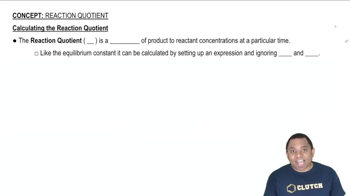Calculate the solubility (in grams per 1.00⨉102 mL of solution) of magnesium hydroxide in a solution buffered at pH = 10. How does this compare to the solubility of Mg(OH)2 in pure water?
Ch.18 - Aqueous Ionic Equilibrium
Chapter 18, Problem 108
A solution containing potassium bromide is mixed with one containing lead acetate to form a solution that is 0.013 M in KBr and 0.0035 M in Pb(C2H3O2)2. Does a precipitate form in the mixed solution? If so, identify the precipitate.
 Verified step by step guidance
Verified step by step guidance1
Identify the possible reaction: When potassium bromide (KBr) and lead acetate (Pb(C_2H_3O_2)_2) are mixed, the possible reaction is the formation of lead bromide (PbBr_2) and potassium acetate (K(C_2H_3O_2)).
Write the balanced chemical equation: KBr + Pb(C_2H_3O_2)_2 \rightarrow PbBr_2 + 2K(C_2H_3O_2).
Determine the solubility product (K_sp) for PbBr_2: Look up the K_sp value for lead bromide (PbBr_2) in a solubility table.
Calculate the ion product (Q) for PbBr_2: Use the concentrations of Pb^{2+} and Br^- ions in the mixed solution to calculate Q. The concentration of Br^- is twice that of KBr, and the concentration of Pb^{2+} is the same as Pb(C_2H_3O_2)_2.
Compare Q with K_sp: If Q > K_sp, a precipitate of PbBr_2 will form. If Q < K_sp, no precipitate will form.
Key Concepts
Here are the essential concepts you must grasp in order to answer the question correctly.
Solubility Product Constant (Ksp)
The solubility product constant (Ksp) is a numerical value that represents the equilibrium between a solid and its ions in a saturated solution. It is specific to a particular compound at a given temperature. For a precipitate to form, the product of the concentrations of the ions in solution must exceed the Ksp value of the potential precipitate.
Recommended video:
Guided course

Solubility Product Constant
Precipitation Reactions
Precipitation reactions occur when two soluble salts react in solution to form an insoluble compound, known as a precipitate. This process is driven by the formation of a solid that separates from the liquid phase, often indicated by a change in color or turbidity. Identifying the ions involved helps predict whether a precipitate will form.
Recommended video:
Guided course

Selective Precipitation
Ion Concentration and Reaction Quotient (Q)
The reaction quotient (Q) is calculated using the current concentrations of the ions in solution. By comparing Q to the Ksp of a potential precipitate, one can determine if a precipitate will form. If Q exceeds Ksp, a precipitate will form; if Q is less than Ksp, no precipitate will form.
Recommended video:
Guided course

Reaction Quotient Q
Related Practice
Textbook Question
Textbook Question
Determine if each compound is more soluble in acidic solution than it is in pure water. Explain. a. BaCO3 b. CuS c. AgCl d. PbI2
1
views
Textbook Question
A solution containing sodium fluoride is mixed with one containing calcium nitrate to form a solution that is 0.015 M in NaF and 0.010 M in Ca(NO3)2. Does a precipitate form in the mixed solution? If so, identify the precipitate.
Textbook Question
Predict whether a precipitate will form if you mix 75.0 mL of a NaOH solution with pOH = 2.58 with 125.0 mL of a 0.018 M MgCl2 solution. Identify the precipitate, if any.
Textbook Question
Determine the minimum concentration of the precipitating agent on the right to cause precipitation of the cation from the solution on the left. b. 0.085 M CaI2; K2SO4
